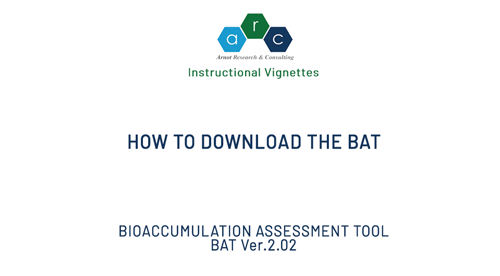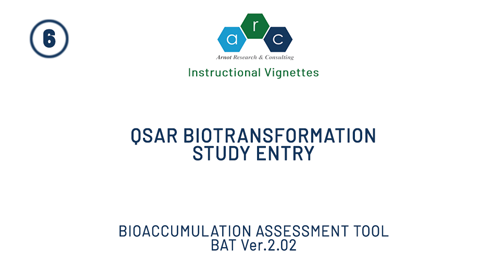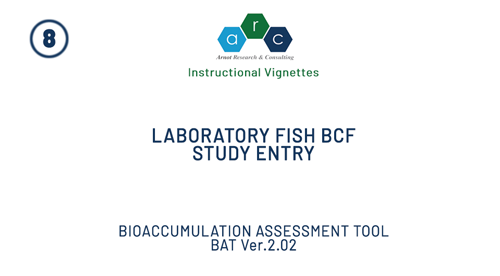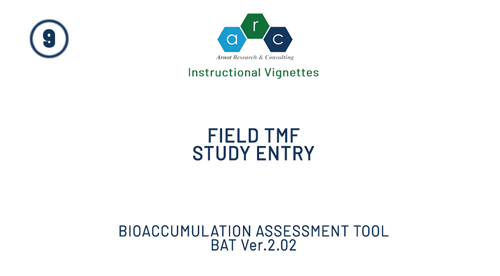MODELS
The Bioaccumulation Assessment Tool (BAT)
Chemicals are being assessed for bioaccumulation (B) potential using various lines of evidence, methods, metrics and classification criteria. In vivo laboratory-based lines of evidence include the bioconcentration factor (BCF) and biomagnification factor (BMF). In vitro biotransformation rate data (S9, hepatocytes) can also be applied for “B” assessment using in vitro-in vivo extrapolation (IVIVE) methods. Field-based lines of evidence include the BMF, bioaccumulation factor (BAF), and the Trophic Magnification Factor (TMF). In silico lines of evidence include quantitative structure-activity relationships (QSARs) for the BCF and the biotransformation rate constant and mass balance bioaccumulation (toxicokinetic) models.
Jon Arnot and colleagues routinely work with multiple stakeholders from academia, government, and industry to improve methods and guidance for bioaccumulation assessment. Part of these efforts resulted in a peer-reviewed paper entitled “A weight of evidence approach for bioaccumulation assessment” that was published in a special issue of the Society of Environmental Toxicology and Chemistry (SETAC) journal Integrated Environmental Assessment and Management. The paper outlines a Weight of Evidence (WOE) approach for bioaccumulation assessment that includes guidance for collecting and generating in vitro, in vivo and in silico data (lines of evidence) to inform bioaccumulation assessment and methods for critically evaluating data reliability for sources of error and uncertainty and integrating the data to aid bioaccumulation assessment decision-making. The reliability of the data is determined using methods developed from standard testing guidance, e.g., OECD TG 305 for bioconcentration and biomagnification testing in fish (2012). The approach for evaluating bioaccumulation in air-breathing organisms is aligned with expert opinion provided in 2022 to the European Chemicals Assessment Agency (ECHA). In the Arnot et al., 2023 publication the methods were applied as case examples for two Persistent Organic Pollutants (POPs) and for evaluating bioaccumulation in aquatic and air-breathing organisms. The WOE approach is aligned with the Guiding Principles and Key Elements for Establishing a Weight of Evidence for Chemical Assessment provided by the Organization for Economic Coordination and Development (OECD). The bioaccumulation assessment methods and guidance are also aligned with the OECD guidance for Integrated Approaches to Testing and Assessment (IATA). In fact, there is an OECD IATA for Bioaccumulation freely available for download at the OECD that uses the methods and tools developed by ARC.
The Bioaccumulation Assessment Tool (BAT) was developed to help interested parties apply the bioaccumulation assessment methods and guidance in a pragmatic manner. The BAT guides the collection, generation, evaluation, and integration of various lines of evidence to aid bioaccumulation assessment decision-making for aquatic and air-breathing organisms. The BAT facilitates the systematic and transparent integration of information in a consistent framework to inform bioaccumulation assessment decision-making by providing a Weight of Evidence (WOE) approach that includes critical evaluations of data confidence (quality). The BAT is implemented (coded) in Visual Basic for Applications (VBA) and the Graphical User Interface is designed in Excel™. The BAT User Manual and Quick Start Guide are embedded as pdfs within the Excel file. The BAT is free and downloadable using the registration and links provided below. BAT Ver.1.0 was released October 2018.BAT Ver.1.01 was released September 2019, BAT Ver2.0 was released May 2021 and BAT Ver.2.02 was released September 2021. The BAT was developed with stakeholder involvement including representatives from academia, government, and industry with research support from Cefic LRI and the ACC LRI.
The BAT includes state of the science bioaccumulation models for calculating various bioaccumulation metrics in aquatic and air-breathing organisms under laboratory and field conditions of exposure (e.g., BCFs, BMFs, BAFs, TMFs). The WOE methods were primarily developed for chemicals with multiple lines of evidence, i.e., relatively “data rich” chemicals. For screening-level bioaccumulation assessments for relatively “data poor” chemicals, please consider using the Bioaccumulation Estimation Tool (BET) that is part of the freely accessible on-line Exposure and Safety Estimation (EAS-E) Suite platform. The BET can be parameterized with only chemical structure (SMILES notation), name or CAS number and users have the option to include measured in vitro and in vivo data to refine the BET calculations of various bioaccumulation metrics in aquatic and air-breathing organisms under laboratory and field conditions of exposure (e.g., BCFs, BMFs, BAFs). The BET models are consistent with those in the BAT so users can proceed from screening-level bioaccumulation assessments to a WOE approach following an OECD IATA for bioaccumulation assessment, when necessary.
References
Arnot J, Birk B, Curtis-Jackson P, Gobas FAPC, Goss K-U, Habekost M, Hirmann D, Bonnomet V, Hofer T, Jacobi S, Krause S, Laue H, Laurentie M, Aparicio AM, van der Mescht M, Rauert C, Treu G, Redman A, Saunders LJ, Verbruggen E, Wania F, Whalley P. 2022. Bioaccumulation assessment of air-breathing mammals: a discussion paper. European Chemical Agency (ECHA), Helsinki. Link here.
Arnot JA, Toose L, Armitage JM, Embry M, Sangion A, Hughes L. 2023. A weight of evidence approach for bioaccumulation assessment. Integrated Environmental Assessment and Management 19:1235–1253. DOI: 10.1002/ieam.4583.
OECD. 2012. Test No. 305: Bioaccumulation in Fish: Aqueous and Dietary Exposure, OECD Guidelines for the Testing of Chemicals, Section 3, OECD Publishing, Paris, https://doi.org/10.1787/9789264185296-en.
OECD. 2019. Guiding Principles and Key Elements for Establishing a Weight of Evidence for Chemical Assessment. Organisation for Economic Co-ordination and Development, Paris. Link here.
OECD. 2020. Overview of Concepts and Available Guidance related to Integrated Approaches to Testing and Assessment (IATA). Series on Testing and Assessment No. 329. Organisation for Economic Cooperation and Development, Paris, France. Link here.
OECD. 2024. Case study on the Use of Integrated Approaches for Testing and Assessment (IATA) for Bioaccumulation – Ninth Review Cycle (2023), OECD Series on Testing and Assessment, No. 404, OECD Publishing, Paris, https://doi.org/10.1787/8bc8ad6f-en.
The downloadable materials included on this website are provided to interested parties at no cost; however, to download any material you need to register by completing a form with your name, e-mail address and affiliation. The registration information provides us with contact information so that we can send notifications for model updates. The models are updated occasionally to address potential errors and “bugs in the code” and to reflect scientific advancements. For more information about these models, tools and databases please contact Jon Arnot.
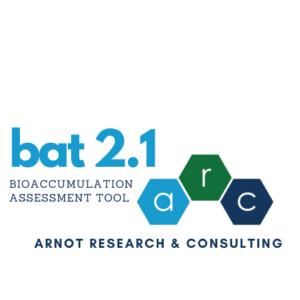

We have made some minor, but important, updates to BAT Ver.2.0. The BAT Ver.2.02 is available for free download at the link below. BAT Ver.2.02 includes several new features:
- Lines of Evidence (LoE) are now only included in the Strength of Evidence (SoE) summary table, IF the LoE has a reliability score (RS) > 0. For transparency, all LoE data are still displayed in the Summary Results Sheet.
- Updated default parameters for the built-in BAT model calculations lab B-metrics for aquatic species to reflect median values from experimental bioaccumulation testing databases.
- Addition of user-defined weighting of biotransformation study types to the Chemical Summary Sheet for parameterizing the built-in BAT model. Defaults are provided if the user does not choose their own values.
- Addition of a user-defined option for scaling fish biotransformation rate constants to invertebrate biotransformation rate constants to parameterize the built-in BAT models.
- Addition of a user-selected option for choosing whether to use growth corrected B metrics from lab studies in the Weight of Evidence (WoE).
- BAT Bug Fixes / Corrections:
- Error in field bioaccumulation factor (BAFSS) calculation.
- Error in steady-state and kinetic lab B-metric calculation output provided by the built-in BAT models; output are now consistent.
- Total elimination half-life (HLT) output erroneously appeared in units of hours, but it was labelled days; output units now corrected to days.

This Quick Start Guide can be considered to expedite the use of the BAT; however, all BAT users are strongly encouraged to read the User Manual before using the BAT.
Demonstration Videos for using the BAT
How to Cite BAT Ver 2.02:
Arnot JA, Toose L, Armitage JM, Embry M, Sangion A, Hughes L. 2023. A weight of evidence approach for bioaccumulation assessment. Integrated Environmental Assessment and Management19:1235–1253. DOI: 10.1002/ieam.4583.
Limitations of liability and disclaimer of warranty
ARC Arnot Research & Consulting Inc. and all associated collaborators do not guarantee, warrant, or make any representations, either expressed or implied, regarding the use, or the results of the use of the materials provided with regards to reliability, accuracy, correctness, or otherwise. There are no warranty rights granted to users of the models or databases provided.
Users assume the entire risk as to the results and performance of the models and databases. ARC Arnot Research & Consulting Inc. and all associated collaborators are not liable under any circumstances, for any damages whatsoever, arising out of the use, or the inability to use, the models and databases provided, even if advised of the possibility of such damages.

